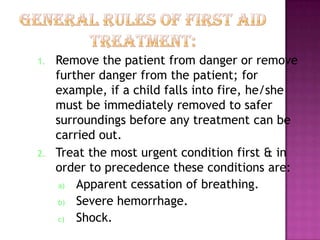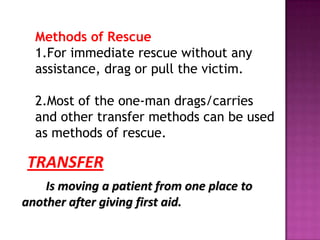First aid is immediate care for injured or ill persons until full medical treatment is available. It includes steps like controlling bleeding, treating for shock, and calling for help. Key principles of first aid response include assessing safety, checking consciousness, breathing, and circulation, and calling for emergency help if needed. Proper first aid management of common injuries and illnesses includes treating wounds, sprains, fractures, fever, headache, abdominal pain, and vomiting/diarrhea by addressing symptoms, elevating injuries, applying pressure or ice as needed, and seeking further care if the condition does not improve. First aiders should remove victims from danger, treat life threats first, and use appropriate carries or drags to transfer patients as required by their condition









































![The Philippine National Red Cross
(2007). Participant’s
Workbook:Standard First Aid.
Philippine Copyright, 1999
CERT Los Angeles Lifts and Carries
(2001). [Accessed
online]http://www.certla.com/liftcarry
/Liftcarry.htm
References:](https://image.slidesharecdn.com/principles-140426064510-phpapp01/85/Principles-of-first-aid-edith-42-320.jpg)